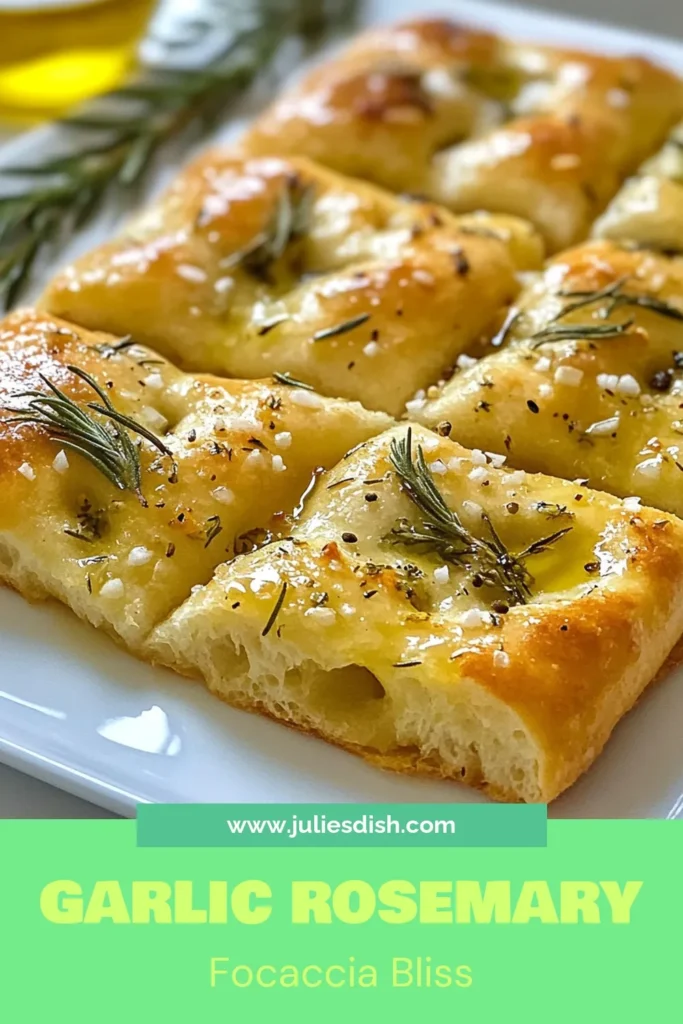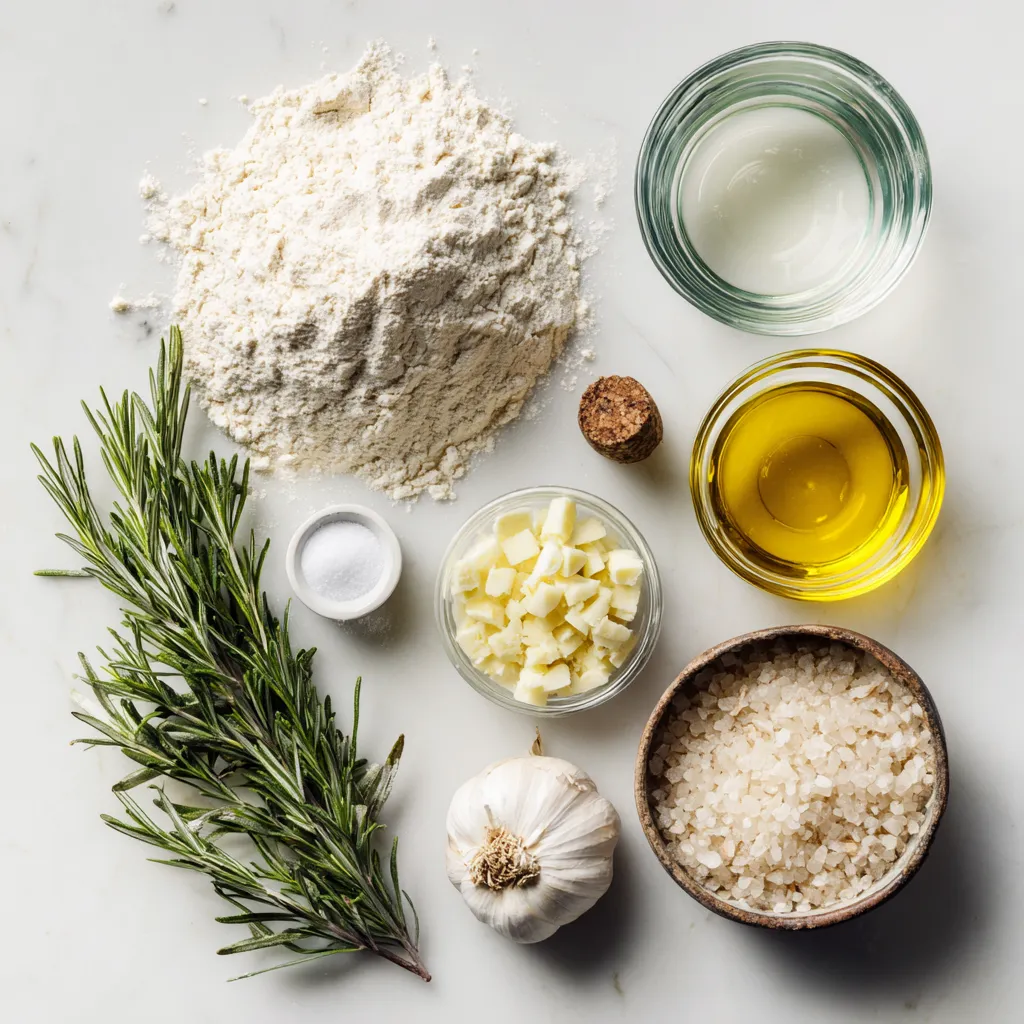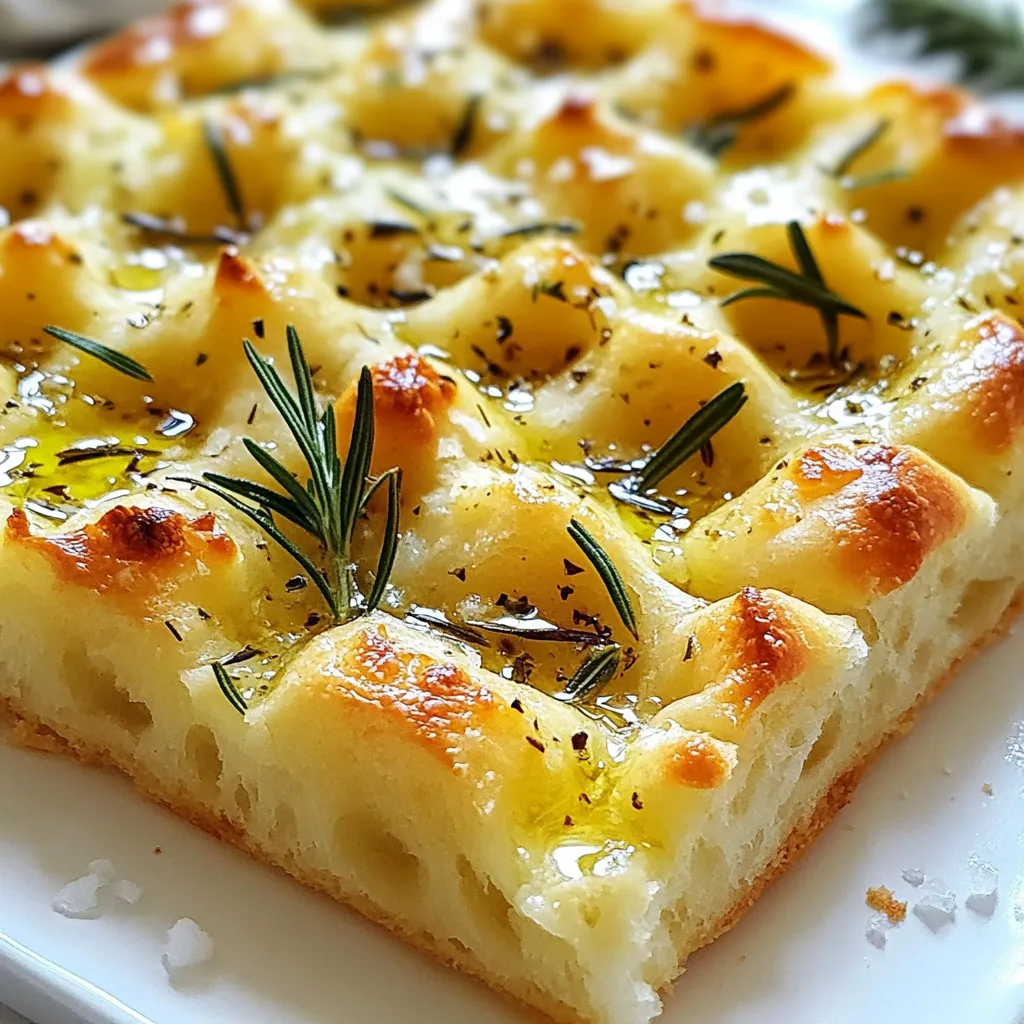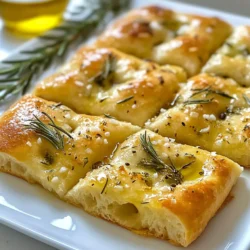WANT TO SAVE THIS RECIPE?
Who can resist the warm aroma of homemade Garlic Rosemary Focaccia Bread? This recipe combines simple ingredients to create a soft, flavorful loaf that’s perfect for dipping or enjoying on its own. Whether you’re a beginner or a seasoned baker, I’ll guide you through each step. Get ready to impress your family and friends with this tasty treat that will elevate your baking game to new heights! Let’s dive in!
Why I Love This Recipe
- Delicious Flavor Profile: The combination of garlic and rosemary infuses the bread with an aromatic and savory taste that elevates any meal.
- Easy to Make: This focaccia bread recipe requires simple ingredients and straightforward steps, making it perfect for both novice and seasoned bakers.
- Perfectly Dippable: Its soft, airy texture and flavorful crust make it ideal for dipping in olive oil, balsamic vinegar, or your favorite spreads.
- Versatile Serving Options: This focaccia can be enjoyed as a side dish, a sandwich base, or even as a standalone snack, making it a versatile addition to any table.
Ingredients
Required Ingredients
– 4 cups all-purpose flour
– 1 tablespoon active dry yeast
– 1 ½ cups warm water
– 1 teaspoon sugar
– 2 teaspoons salt
– 1/4 cup olive oil
– 4 cloves garlic
– 2 tablespoons fresh rosemary
– Coarse sea salt
To make this garlic rosemary focaccia bread, you need simple, fresh ingredients. All-purpose flour gives the bread its soft texture. Active dry yeast helps it rise and become fluffy. Warm water activates the yeast, while sugar feeds it. Salt adds flavor. Olive oil keeps the bread moist and creates a nice crust. Garlic and rosemary bring that aromatic touch we all love. Finally, coarse sea salt on top adds a great crunch.
Optional Ingredients
– Additional herbs and spices
– Topping ideas for flavor enhancement
You can play with flavors by adding extra herbs or spices. Try thyme or oregano for a twist. For toppings, consider adding cheese or sun-dried tomatoes. These options let you customize the focaccia to your taste.

Step-by-Step Instructions
Preparing the Yeast Mixture
Start by taking a small bowl. Combine 1 ½ cups of warm water, 1 teaspoon of sugar, and 1 tablespoon of active dry yeast. Stir gently to mix. Let this sit for about 5 to 10 minutes. You want it to become bubbly and foamy. This shows the yeast is alive and ready to work.
Mixing the Dough
In a large mixing bowl, combine 4 cups of all-purpose flour and 2 teaspoons of salt. Make a well in the center of the flour mix. Pour in your bubbly yeast mixture and 1/4 cup of olive oil. Use a wooden spoon to mix until a soft dough forms. It should not be sticky.
Kneading and Rising
Next, turn the dough out onto a floured surface. Knead it for about 8 to 10 minutes. You want it to be smooth and elastic. Once done, place the dough in a lightly greased bowl. Cover it with a damp cloth and set it in a warm spot. Let it rise for 1 to 2 hours, until it doubles in size.
Shaping and Dimpling the Dough
Once the dough has risen, punch it down gently. Turn it out onto a greased baking sheet or stone. Shape it into a rectangle about 1 inch thick. Using your fingers, press down to create deep dimples all over the surface. This will hold the toppings well.
Baking Process
Preheat your oven to 400°F (200°C) while the dough rises. After dimpling, mix 4 cloves of minced garlic with 2 tablespoons of chopped rosemary and a drizzle of olive oil in a small bowl. Brush this mixture all over the dough. Sprinkle coarse sea salt on top. Let it rise again for 20 to 30 minutes. Bake for 20 to 25 minutes, until golden brown. Check for a crispy crust and a soft inside.
Tips & Tricks
Perfecting the Dough Texture
A good dough should be smooth and elastic. When you knead it, it should bounce back when poked. If your dough feels too sticky, add a bit more flour. If it seems dry, add a touch of water. You want it soft but not gooey.
Enhancing Flavor
Using fresh garlic and rosemary makes a big difference. Chop the garlic finely so it spreads evenly. The rosemary should be fresh for the best taste. If you want to mix things up, try adding olives or sun-dried tomatoes. These can add great flavor and texture.
Common Mistakes to Avoid
One common mistake is under-proofing the dough. This means not letting it rise enough. If it doesn’t double in size, it won’t be fluffy. Over-proofing can also happen if you leave it too long. This makes the dough collapse. To get a nice crust, bake it until it is golden brown. A crisp crust makes the focaccia stand out.
Pro Tips
- Use Fresh Ingredients: Fresh rosemary and garlic will give your focaccia the best flavor. Look for vibrant, aromatic herbs in the produce section.
- Perfect Dough Consistency: The dough should be soft but not sticky. If it’s too sticky, add a little more flour while kneading until you achieve the right texture.
- Allow for Proper Rising: Make sure to let the dough rise in a warm environment to activate the yeast effectively. A turned-off oven with the light on works well.
- Enhance with Toppings: Feel free to experiment with toppings like olives, sun-dried tomatoes, or cheese. Just make sure not to overload it, which could affect the baking time.

Variations
Additional Toppings
You can mix things up with toppings. Here are some fun ideas:
– Cheese options: Try adding mozzarella or parmesan on top. These cheeses melt nicely and add a rich flavor.
– Other herbs and spices: Experiment with thyme, oregano, or even red pepper flakes. Each adds a unique twist to your focaccia.
Dietary Adjustments
If you have dietary needs, there are easy swaps:
– Gluten-free flour alternatives: You can use a gluten-free flour blend. Make sure it has a binding agent like xanthan gum for the best texture.
– Vegan substitutions for olive oil: Instead of olive oil, try avocado oil or coconut oil. Both work well and add their own flavor.
Different Focaccia Styles
Focaccia has many styles you can explore:
– Mediterranean-style variations: Add olives, sun-dried tomatoes, or feta cheese for a Mediterranean touch. These ingredients give your bread a bold taste.
– Sweet focaccia recipes: For a sweet twist, try adding honey or cinnamon. You can even use fruits like figs or apples for a delightful dessert bread.
Storage Info
Best Practices for Storage
After you bake your focaccia, let it cool completely. This step is key. If you wrap it too soon, steam builds up and makes the crust soggy. Once cool, wrap the bread tightly in plastic wrap or foil. This helps keep it fresh and soft. Store it at room temperature for up to three days.
Refrigeration and Freezing
For longer storage, you can refrigerate or freeze the focaccia. If you choose to refrigerate it, wrap it well and store it for up to a week. For freezing, slice the bread first. Then wrap each piece in plastic wrap and place them in a freezer bag. This way, you can grab a slice whenever you want. Focaccia can stay frozen for up to three months.
When you’re ready to eat, reheat it in the oven. Set the oven to 350°F (175°C). Wrap the bread in foil to keep it moist. Heat for about 10-15 minutes. This brings back the crusty texture. Enjoy your delicious focaccia warm and fresh!
FAQs
How do I know if my yeast is active?
You can tell if your yeast is active by checking for bubbles. First, mix warm water, sugar, and yeast in a bowl. Wait for about 5-10 minutes. If the mixture looks foamy and bubbly, your yeast is good to use. If there are no bubbles, the yeast may be old or inactive.
Can I use instant yeast instead of active dry yeast?
Yes, you can use instant yeast. It works well as a substitute. Use the same amount as active dry yeast. You can mix it directly into the flour without proofing it first. This saves time, and the bread will still rise nicely.
How do I make focaccia bread without garlic and rosemary?
You can create a simple focaccia without these flavors. Use the same base recipe, but skip the garlic and rosemary. Instead, try adding other herbs like thyme or oregano. You can also top it with cheese, olives, or sun-dried tomatoes for a different taste.
What is the best way to serve garlic rosemary focaccia?
Serve garlic rosemary focaccia warm for the best flavor. It pairs well with soups and salads. You can also use it as a sandwich base. Drizzle with extra olive oil or balsamic vinegar for added taste. Enjoy it fresh, and watch it disappear!
This blog post covered how to make delicious garlic rosemary focaccia. You learned about required and optional ingredients, step-by-step instructions, and tips for the perfect dough. I shared common mistakes to avoid and variations for different tastes.
Now, you can try this recipe with confidence. Enjoy your baking adventure and share your focaccia creations with friends and famil
Garlic Rosemary Focaccia Bread
A delicious and aromatic focaccia bread topped with garlic and rosemary.
Prep Time 15 minutes mins
Cook Time 25 minutes mins
Total Time 2 hours hrs 25 minutes mins
Course Bread
Cuisine Italian
Servings 3
Calories 200 kcal
- 4 cups all-purpose flour
- 1 tablespoon active dry yeast
- 1.5 cups warm water
- 1 teaspoon sugar
- 2 teaspoons salt
- 0.25 cup olive oil
- 4 cloves garlic, minced
- 2 tablespoons fresh rosemary, chopped
- 1 pinch coarse sea salt for topping
In a small bowl, combine warm water, sugar, and yeast. Let it sit for about 5-10 minutes until bubbly and foamy.
In a large mixing bowl, combine the flour and salt. Make a well in the center and pour in the yeasty mixture along with 1/4 cup of olive oil.
Mix with a wooden spoon until a soft dough forms.
Knead the dough on a floured surface for about 8-10 minutes until it becomes smooth and elastic.
Place the dough in a lightly greased bowl, cover it with a damp cloth, and let it rise in a warm place for about 1-2 hours, or until it doubles in size.
Preheat your oven to 400°F (200°C) while the dough is rising.
Once risen, punch down the dough and turn it out onto a greased baking sheet or a stone. Stretch and shape it into a rectangle about 1 inch thick.
Using your fingers, create deep dimples all over the surface of the dough.
In a small bowl, mix the minced garlic with the chopped rosemary and a drizzle of olive oil. Brush this mixture generously over the dough.
Sprinkle coarse sea salt over the top and let it rise for another 20-30 minutes.
Bake in the preheated oven for 20-25 minutes, or until golden brown.
Remove from the oven and let it cool slightly before cutting into pieces.
Best served warm with olive oil for dipping.
Keyword bread, focaccia, garlic, rosemary
WANT TO SAVE THIS RECIPE?





